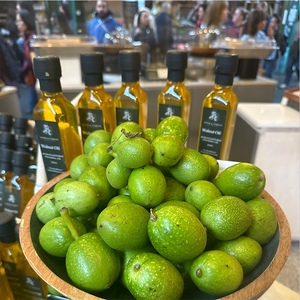


Fresh Green Walnuts
Estimated Inventory, lb : 0
Description/Taste
Green Walnuts are ovate and consistently sized with a three-centimeter diameter and a hard, lime-green skin speckled with tiny white dots. Beneath the skin, the walnut is white and underdeveloped with a gelatinous, sticky, and syrupy consistency. Green Walnuts are highly aromatic with a bright spiced-citrus flavor intertwined with notes of pine and bay leaves. The nuts have an astringent taste with orange, nutmeg, and all-spice notes and a strong, bitter finish.
Seasons/Availability
Green Walnuts are available in the late spring.
Current Facts
Green Walnuts are the unripe fruits of many walnut tree varieties, including Black walnuts, Persian walnuts, and Butternuts, which are native to the eastern United States. The fruits are harvested when the hull is still intact and the nut is still soft and nearly liquid in the shell. At this stage, the walnut is edible and is prized for its sticky, syrupy consistency and spiced citrus, bitter flavor. The fruits must be harvested from the tree with gloves as the juice can be messy and may stain hands and clothing. If left on the tree, the walnuts will ripen and can be used in a variety of different applications. They are also used for their oil, to make dye, and their wood is highly prized for its color, hardness, and beautiful grain. Once the hull turns yellow, the nut is too mature to be consumed whole.
Nutritional Value
Walnuts are an excellent source of omega-3 fatty acids, specifically alpha-linolenic acid, which boosts memory, concentration, and cognitive function. The nuts are also a rich source of vitamins and minerals known to support the brain and the immune system, including vitamin E, copper, selenium, iron, and niacin.
Applications
Green Walnuts are harvested before they fully develop, resulting in a gelatinous and syrupy consistency and a bitter, astringent flavor with spiced citrus notes. The whole fruits are commonly used to produce condiments, pickles, sweets, preserves, and a variety of liqueurs. One such liqueur, Vin de Niox, is made when Green Walnuts are steeped in red wine with aromatics like citrus and cinnamon. The fruits eventually dissolve in the liquid, imparting their piney, bitter, and citrusy flavor. The fruits can be peeled with a sharp knife to remove some of the outer husk and then soaked in syrup until candied. In Greece, a similar recipe is made using pickling lime, and in Italy, the fruits are soaked in simple syrup and then strained. These candied fruits can be served over ice cream, cake, and other confections. Green Walnuts should be refrigerated and used within three weeks for optimal freshness.
Ethnic/Cultural Info
The tradition of harvesting Green Walnuts dates to antiquity, with some of the earliest documentation of their use being found during the Roman occupation of Celtic lands in what is now Britain and Scotland. Stories tell of early Celtic tribes that would send barefoot virgins into the walnut groves to harvest the unripe fruits on the summer solstice each year, believing that if the pure and green fruits are harvested when the sun’s energies were at their fullest, by the purest of souls, that they could ward off evil during the darkest parts of the year. The green fruits were steeped in mead or wine for six months to be enjoyed on the winter solstice, the longest night of the year. Many cultures have co-opted this Celtic tradition, and the timing has been changed to coincide with the Christian holiday of St. John’s Day, ultimately removing its pagan origins, but the practice of barefoot collection by young women has remained in the Northern United Kingdom.
Geography/History
Walnuts were first found in Persia and are native to a region across Asia, stretching from the Balkans to China, and have been eaten in the area for over 8,000 years. The nuts were highly prized in Ancient Greece and Rome and enjoyed in China since 200 BCE. The nuts were spread throughout Europe by the Roman Empire during Charlemagne’s rule and along trade routes through Asia and the Middle East. By the Middle Ages, walnuts were cultivated as far north as England. The English are credited with spreading the nuts to other parts of the world, including North and South America, which is how the nuts came to be known as English Walnuts. Walnuts flourished in the Mediterranean-like climate of California, and by the 1870s, commercial production began in California. Today, the world’s leading producers of walnuts are China, the United States, Iran, and Turkey. Walnuts can be found in most supermarkets, grocery stores, and natural food stores in North America, Europe, and China.
Recipe Ideas
Recipes that include Fresh Green Walnuts. One
| Yum! |
|
Green Walnut Nocino |
| The Urbane Forager |
|
Pickled Green Walnuts |
| Taste of Beirut |
|
Green Walnut Preserves |
















